Oct
21
2024
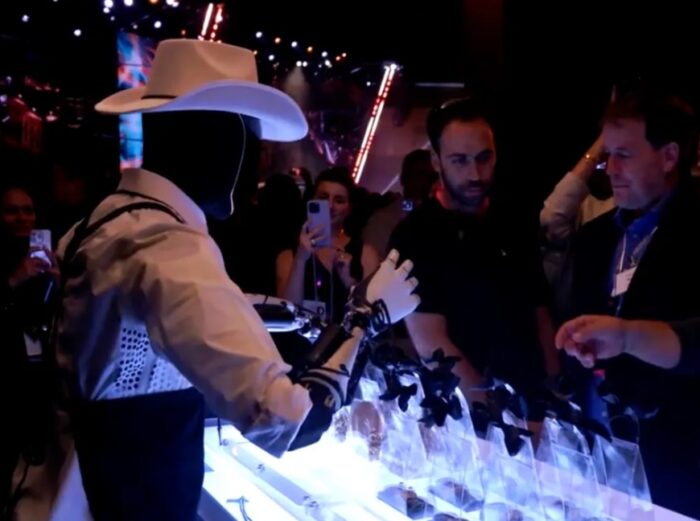 At a recent event Tesla showcased the capabilities of its humanoid autonomous robot, Optimus. The demonstration has come under some criticism, however, for not being fully transparent about the nature of the demonstration. We interviewed robotics expert, Christian Hubicki, on the SGU this week to discuss the details. Here are some of the points I found most interesting.
At a recent event Tesla showcased the capabilities of its humanoid autonomous robot, Optimus. The demonstration has come under some criticism, however, for not being fully transparent about the nature of the demonstration. We interviewed robotics expert, Christian Hubicki, on the SGU this week to discuss the details. Here are some of the points I found most interesting.
First, let’s deal with the controversy – to what extent were the robots autonomous, and how transparent was this to the crowd? The first question is easier to answer. There are basically three types of robot control, pre-programmed, autonomous, and teleoperated. Pre-programmed means they are following a predetermined set of instructions. Often if you see a robot dancing, for example, that is a pre-programmed routine. Autonomous means the robot has internal real-time control. Teleoperated means that a human in a motion-capture suit is controlling the movement of the robots. All three of these types of control have their utility.
These are humanoid robots, and they were able to walk on their own. Robot walking has to be autonomous or pre-programmed, it cannot be teleoperated. This is because balance requires real-time feedback of position and other information to produces the moment-to-moment adjustments that maintain balance. A tele-operator would not have this (at least not with current technology). The Optimus robots walked out, so this was autonomous.
Continue Reading »
Oct
17
2024
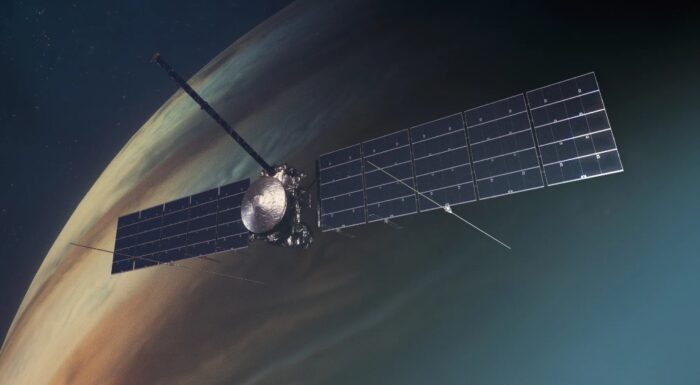 I wrote earlier this week about the latest successful test of Starship and the capture of the Super Heavy booster by grabbing arms of the landing tower. This was quite a feat, but it should not eclipse what was perhaps even bigger space news this week – the launch of NASAs Clipper probe to Europa. If all goes well the probe will enter orbit around Jupiter in 2030.
I wrote earlier this week about the latest successful test of Starship and the capture of the Super Heavy booster by grabbing arms of the landing tower. This was quite a feat, but it should not eclipse what was perhaps even bigger space news this week – the launch of NASAs Clipper probe to Europa. If all goes well the probe will enter orbit around Jupiter in 2030.
Europa is one of the four large moons of Jupiter. It’s an icy world but one with a subsurface ocean – an ocean that likely contains twice as much water as the oceans of Earth combined. Europa is also one of the most likely locations in our solar system for life outside Earth. It is possible that conditions in that ocean are habitable to some form of life. Europa, for example, has a rocky core, which may still be molten, heating Europa from the inside and seeding its ocean with minerals. Chemosynthetic organisms survive around volcanic vents on Earth, so we know that life can exist without photosynthesis and Europa might have the right conditions for this.
But there is still a lot we don’t know about Europa. Previous probes to Jupiter have gathered some information, but Clipper will be the first dedicated Europa probe. It will make 49 close flybys over a 4 year primary mission, during which it will survey its magnetic field, gravity, and chemical composition. Perhaps most exciting is that Clipper is equipped with instruments that can sample any material around Europa. The hope is that Clipper will be able to fly through a plume of material shooting up geyser-like from the surface. It would then be able to detect the chemical composition of Europa material, especially looking for organic compounds.
Continue Reading »
Oct
14
2024
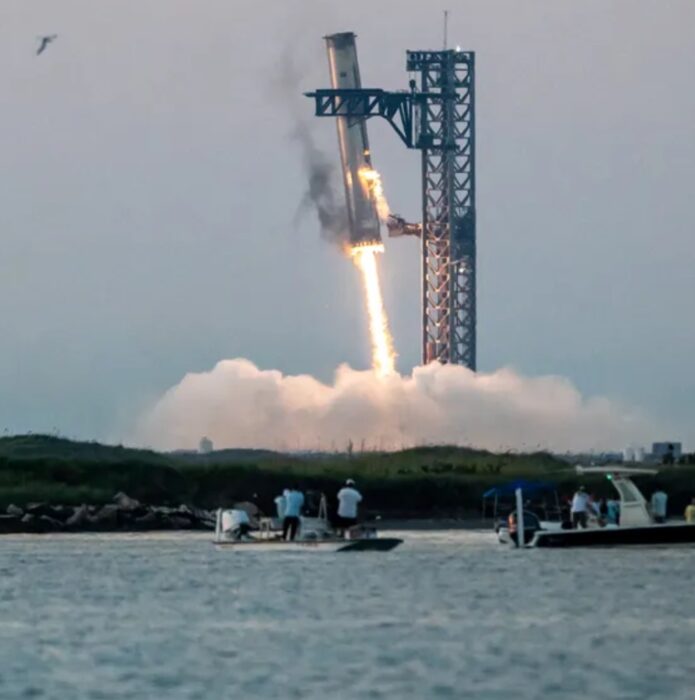 SpaceX has conducted their most successful test launch of a Starship system to date. The system they tested has three basic components – the Super Heavy first stage rocket booster, the Starship second stage (which is the actual space ship that will go places), and the “chopsticks”, which is a mechanical tower designed to catch the Super Heavy as it returns. All three components apparently functioned as hoped.
SpaceX has conducted their most successful test launch of a Starship system to date. The system they tested has three basic components – the Super Heavy first stage rocket booster, the Starship second stage (which is the actual space ship that will go places), and the “chopsticks”, which is a mechanical tower designed to catch the Super Heavy as it returns. All three components apparently functioned as hoped.
The Super Heavy lifted Starship into space (suborbital), then returned to the launch pad in Southern Texas where it maneuvered into the grasping mechanical arms of the chopsticks. The tower’s arms closed around the Super Heavy, successfully grabbing it. The engines then turned off and the rocket remained held in place. The idea here is to replicate the reusable function of the Falcon rockets, which can return to a landing pad after lifting their cargo into orbit. The Falcons land on a platform one the water. SpaceX, however, envisions many Starship launches and wants to be able to return the rockets directly to the launch pad, for quicker turnaround.
The Starship, for its part, also performed as expected. It came back down over the designated target in the Indian Ocean. Once it got to the surface it rolled on its side and exploded. They were never planning on recovering any of the Starship so this was an acceptable outcome. Of course, eventually they will need to land Starship safely on the ground.
The system that SpaceX came up with reflects some of the realities and challenges of space travel. The Earth is a massive gravity well, and it is difficult to get out of and back into that gravity well. Getting into orbit requires massive rockets with lots of fuel, and falls prey to the rocket equation – you need fuel to carry the fuel, etc. This is also why, if we want to use Starship to go to Mars, SpaceX will have to develop a system to refuel in orbit.
Continue Reading »
Oct
11
2024
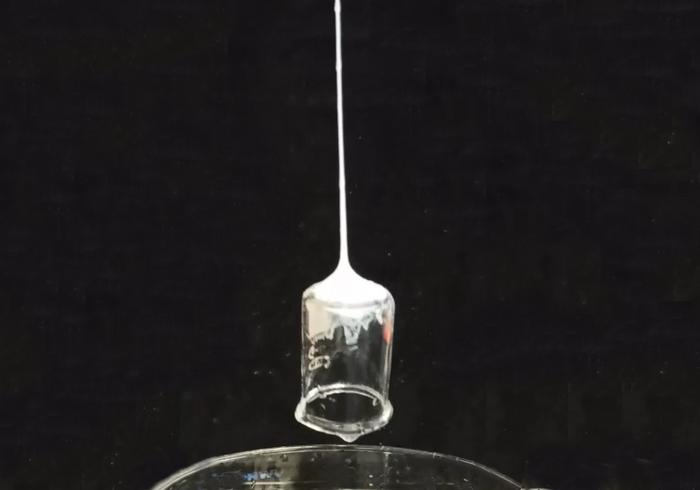 I have to admit that my favorite superhero as a kid, and still today, is Spider-Man (and yes, that’s the correct spelling). There are a number of narrative reasons for this that I grew to appreciate more as I aged. First, Spider-Man is in the sweet spot of super abilities – he is strong, fast, agile, and has “spidey senses”. But he is not boringly invulnerable like Superman. He doesn’t brute force his way to solving situations. You don’t have to retcon questions like – if Ironman has the technology to produce immense energy, why doesn’t he just make it available to the world? He would save more lives that way.
I have to admit that my favorite superhero as a kid, and still today, is Spider-Man (and yes, that’s the correct spelling). There are a number of narrative reasons for this that I grew to appreciate more as I aged. First, Spider-Man is in the sweet spot of super abilities – he is strong, fast, agile, and has “spidey senses”. But he is not boringly invulnerable like Superman. He doesn’t brute force his way to solving situations. You don’t have to retcon questions like – if Ironman has the technology to produce immense energy, why doesn’t he just make it available to the world? He would save more lives that way.
But of course the coolest aspect of Spider-Man is his webslinging. This allows him to fly through the city, and to tie-up villains for the police to collect. This is also one aspect of the Spider-Man story that I thought was a bit contrived (even for the superhero genre where being bitten by a radioactive spider gives you super powers). In science fiction you generally get one gimmie – the author is allowed to make up just one fantastical fact to use as a cornerstone of their story. But they should not introduce multiple such gimmies. It breaks the unwritten contract between author and reader.
With Spider-Man, the one gimmie is the whole radioactive spider thing. That’s the one thing we are being asked to just accept and not question. I do like how more modern versions of the story changed that to genetic engineering – still fantastical, but way more plausible than radioactivity. I also liked that in the Tobey Maguire Spider-Man his webbing was part of the genetic engineering, and he produced the spider silk himself and extruded it from spinners in his wrists. For other versions we are asked to accept a double-gimmie – first, the whole spider thing, and second that Peter Parker also happens to be such a genius that he invented practically overnight something that scientists have been unable to do in decades, mimic the spider silk-spinning of spiders. Spider-Man was created in 1962, and here we are more than 60 years later and this remains an intractable problem of material science.
Or is it?
Continue Reading »
Oct
10
2024
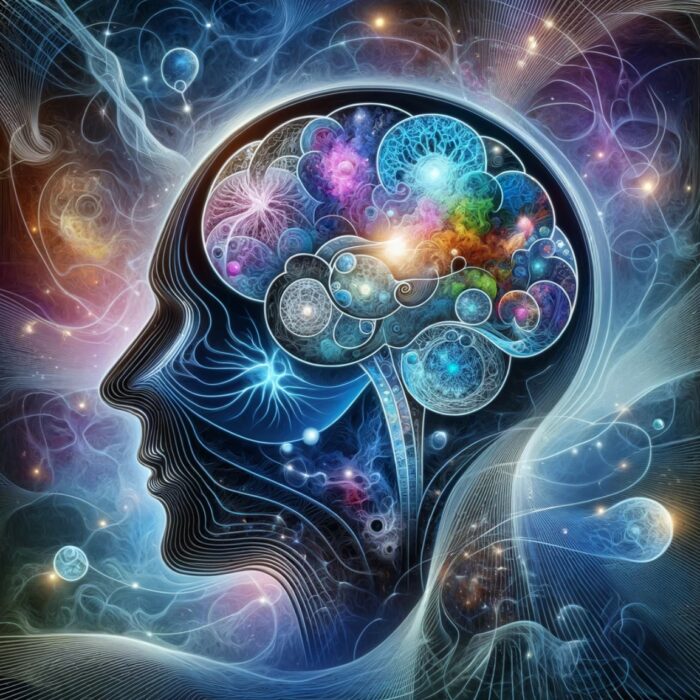 How certain are you of anything that you believe? Do you even think about your confidence level, and do you have a process for determining what your confidence level should be or do you just follow your gut feelings?
How certain are you of anything that you believe? Do you even think about your confidence level, and do you have a process for determining what your confidence level should be or do you just follow your gut feelings?
Thinking about confidence is a form of metacognition – thinking about thinking. It is something, in my opinion, that we should all do more of, and it is a cornerstone of scientific skepticism (and all good science and philosophy). As I like to say, our brains are powerful tools, and they are our most important and all-purpose tool for understanding the universe. So it’s extremely useful to understand how that tool works, including all its strengths, weaknesses, and flaws.
A recent study focuses in on one tiny slice of metacognition, but an important one – how we form confidence in our assessment of a situation or a question. More specifically, it highlights The illusion of information adequacy. This is yet another form of cognitive bias. The experiment divided subjects into three groups – one group was given one half of the information about a specific situation (the information that favored one side), while a second group was given the other half. The control group was given all the information. They were then asked to evaluate the situation and how confident they were in their conclusions. They were also asked if they thought other people would come to the same conclusion.
You can probably see this coming – the subjects in the test groups receiving only half the information felt that they had all the necessary information to make a judgement and were highly confident in their assessment. They also felt that other people would come to the same conclusion as they did. And of course, the two test groups came to the conclusion favored by the information they were given.
Continue Reading »
Oct
08
2024
 I’m going to do something I rarely do and make a straight-up prediction – I think we are close to having AI apps that will function as our all-purpose digital assistants. That’s not really a tough call, we already have digital assistants and they are progressing rapidly. So I am just extending an existing trend a little bit into the future. My real prediction is that they will become popular and people will use them. Predicting technology is often easier than predicting public acceptance and use (see the Segway and many other examples.) So this is more of a risky prediction.
I’m going to do something I rarely do and make a straight-up prediction – I think we are close to having AI apps that will function as our all-purpose digital assistants. That’s not really a tough call, we already have digital assistants and they are progressing rapidly. So I am just extending an existing trend a little bit into the future. My real prediction is that they will become popular and people will use them. Predicting technology is often easier than predicting public acceptance and use (see the Segway and many other examples.) So this is more of a risky prediction.
I know, for those who lived through the early days of personal computers, if you mention “personal digital assistant” the specter of “Clippy” immediately comes to mind. Such assistants can be intrusive and annoying. That has something to do with the fact that they are intrusive and annoying, coupled with the fact that they are not that useful. Siri and similar apps are great for a few things – acting as a verbal interface for Google searchers or serving up music, or basic functions like setting an alarm on your phone. But I am talking next level. Siri is to the AI-fueled assistants I am talking about as the PDAs of the 80s and 90s are to the smartphones of today.
With that analogy I am getting into real tricky prediction territory – predicting a transformative or disruptive technology. This is the kind of technology that, shortly after using it regularly you lose the ability to conceive of life without it. Nor would you want to go back to the dark days before your life was transformed. Think microwave, the ability to record and play pre-recorded content for TV, the web, GPS, and the smartphone. This is what Segway wanted to be.
Continue Reading »
Oct
07
2024
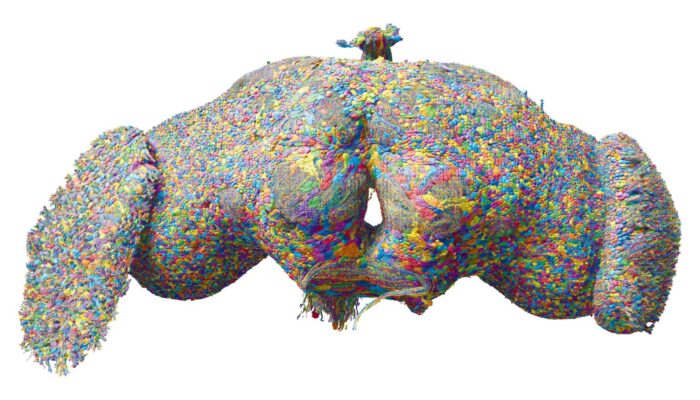 Scientists have just published in Nature that they have completed the entire connectome of a fruit fly: Network statistics of the whole-brain connectome of Drosophila. The map includes 140,000 neurons and more than 50 million connections. This is an incredible achievement that marks a milestone in neuroscience and is likely to advance our research.
Scientists have just published in Nature that they have completed the entire connectome of a fruit fly: Network statistics of the whole-brain connectome of Drosophila. The map includes 140,000 neurons and more than 50 million connections. This is an incredible achievement that marks a milestone in neuroscience and is likely to advance our research.
A “connectome” is a complete map of all the neurons and all the connections in a brain. The ultimate goal is to map the entire human brain, which has 86 billion neurons and about 100 trillion connections – that’s more than six orders of magnitude greater than the drosophila. The human genome project was started in 2009 through the NIH, and today there are several efforts contributing to this goal.
Right now we have what is called a mesoscale connectome of the human brain. This is more detailed than a macroscopic map of human brain anatomy, but not as detailed as a microscopic map at the neuronal and synapse level. It’s in between, so mesoscale. Essentially we have built a mesoscale map of the human brain from functional MRI and similar data, showing brain regions and types of neurons at the millimeter scale and their connections. We also have mesoscale connectomes of other mammalian brains. These are highly useful, but the more detail we have obviously the better for research.
We can mark progress on developing connectomes in a number of ways – how is the technology improving, how much detail do we have on the human brain, and how complex is the most complex brain we have fully mapped. That last one just got its first entry – the fruit fly or drosophila brain.
Continue Reading »
Oct
03
2024
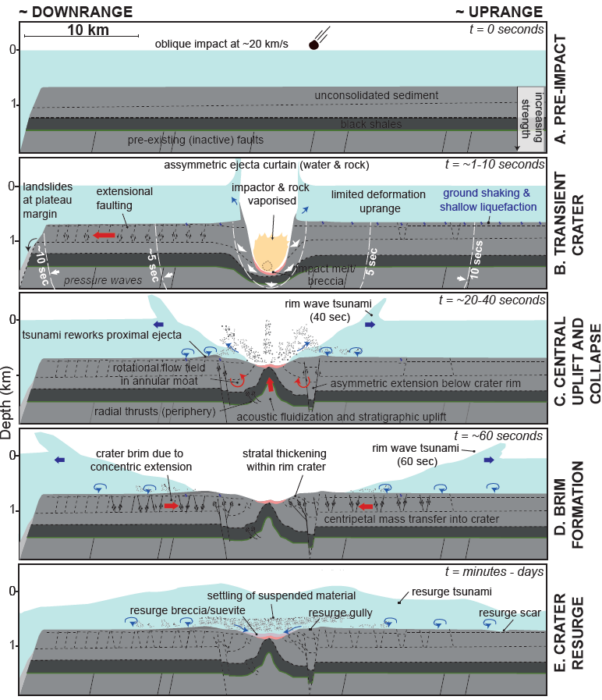 It is now generally accepted that 66 million years ago a large asteroid smacked into the Earth, causing the large Chicxulub crater off the coast of Mexico. This was a catastrophic event, affecting the entire globe. Fire rained down causing forest fires across much of the globe, while ash and debris blocked out the sun. A tsunami washed over North America – one site in North Dakota contains fossils from the day the asteroid hit, including fish with embedded asteroid debris. About 75% of species went extinct as a result, including all non-avian dinosaurs.
It is now generally accepted that 66 million years ago a large asteroid smacked into the Earth, causing the large Chicxulub crater off the coast of Mexico. This was a catastrophic event, affecting the entire globe. Fire rained down causing forest fires across much of the globe, while ash and debris blocked out the sun. A tsunami washed over North America – one site in North Dakota contains fossils from the day the asteroid hit, including fish with embedded asteroid debris. About 75% of species went extinct as a result, including all non-avian dinosaurs.
For a time there has been an alternate theory that intense vulcanism at the Deccan Traps near modern-day India is what did-in the dinosaurs, or at least set them up for the final coup de grace of the asteroid. I think the evidence strongly favors the asteroid hypothesis, and this is the way scientific opinion has been moving. Although the debate is by no means over, a majority of scientists now accept the asteroid hypothesis.
But there is also a wrinkle to the impact theory – perhaps there was more than one asteroid impact. I wrote in 2010 about this question, mentioning several other candidate craters that seem to date to around the same time. Now we have a new candidate for a second KT impact – the Nadir crater off the coast of West Africa.
Geologists first published about the Nadir crater in 2022, discussing it as a candidate crater. They wrote at the time:
“Our stratigraphic framework suggests that the crater formed at or near the Cretaceous-Paleogene boundary (~66 million years ago), approximately the same age as the Chicxulub impact crater. We hypothesize that this formed as part of a closely timed impact cluster or by breakup of a common parent asteroid.”
Continue Reading »
Oct
01
2024
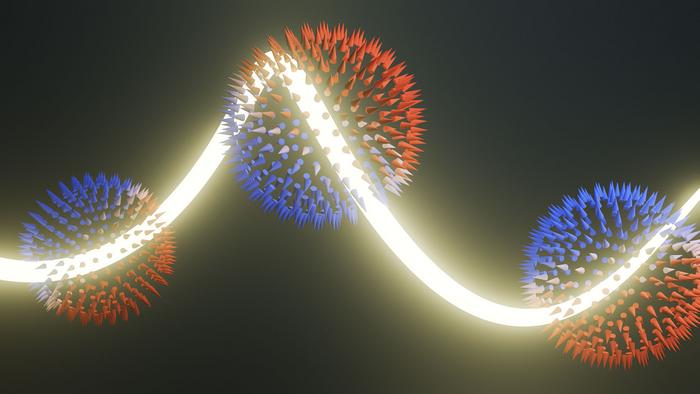 You have definitely heard of electronics. You may (if you are a tech nerd like me) have heard of spintronics and photonics. Now there is also the possibility of orbitronics. What do these cool-sounding words mean?
You have definitely heard of electronics. You may (if you are a tech nerd like me) have heard of spintronics and photonics. Now there is also the possibility of orbitronics. What do these cool-sounding words mean?
Electronic technology is one of those core technologies that has transformed our civilization. Prior to harnessing electricity and developing electrical engineering we essentially had steam punk – mechanical, steam-powered technology. Electronics and electricity to power them, however, opened the door to countless gadgets, from electric lights, appliances, handheld devices, and eventually computer technology and the internet. I am occasionally reminded of how absolutely essential electricity is to my daily life during power outages. I get a brief glimpse of a pre-electronic world and – well, it’s rough. And that’s just a taste, with the real drudgery prolonged life without power would require.
Increasingly electronic devices are computerized, with embedded chips, possibly leading to the “internet of things”. Data centers eat an increasing percentage of our power production, and the latest AI applications will likely dramatically increase that percentage. Power use is now a limiting factor for such technology. It’s one main argument against widespread use of cryptocurrencies, for example. To illustrate the situation, Microsoft has just cut a deal to reopen Unit 1 at the Three-Mile Island nuclear power plant (not the one that melted down, that was Unit 2) with an agreement to purchase all of its power output for 20 years – to power its AI data center.
Therefore there is a lot of research into developing computer hardware that is not necessarily faster, smaller, or more powerful but is simply more energy efficient. We are getting to the limits of physics with the energy efficiency of electronic computers, however. Software engineers are also focusing on this issue, trying to create more energy-efficient algorithms. But it would be nice if the hardware itself used less energy. This is one of the big hopes for developing high temperature superconductors, but we have no idea how long or if we will develop anything usable in computing.
Continue Reading »
Sep
30
2024
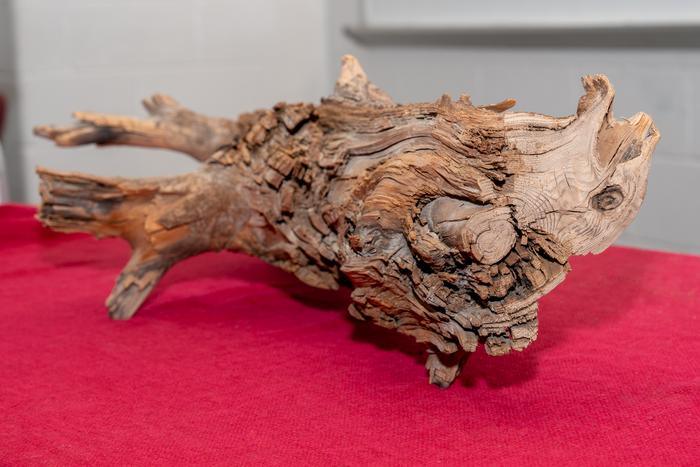 I can’t resist a good science story involving technology that we can possibly use to stabilize our climate in the face of anthropogenic global warming. This one is a fun story and an interesting, and potentially useful, idea. As we map out potential carbon pathways into the future, focusing on the rest of this century, it is pretty clear that it is going to be extremely difficult to completely decarbonize our civilization. This means we can only slow down, but not stop or reverse global warming. Once carbon is released into the ecosystem, it will remain there for hundreds or even thousands of years. So waiting for natural processes isn’t a great solution.
I can’t resist a good science story involving technology that we can possibly use to stabilize our climate in the face of anthropogenic global warming. This one is a fun story and an interesting, and potentially useful, idea. As we map out potential carbon pathways into the future, focusing on the rest of this century, it is pretty clear that it is going to be extremely difficult to completely decarbonize our civilization. This means we can only slow down, but not stop or reverse global warming. Once carbon is released into the ecosystem, it will remain there for hundreds or even thousands of years. So waiting for natural processes isn’t a great solution.
What we could really use is a way to cost-effectively at scale remove CO2 already in the atmosphere (or from seawater – another huge reservoir) to compensate for whatever carbon release we cannot eliminate from industry, and even to reverse some of the CO2 build up. This is often referred to as carbon capture and sequestration. There is a lot of research in this area, but we do not currently have a technology that fits the bill. Carbon capture is small scale and expensive. The most useful methods are chemical carbon capture done at power plants, to reduce some of the carbon released.
There is, however, a “technology” that cheaply and automatically captures carbon from the air and binds it up in solid form – trees. This is why there is much discussion of planting trees as a climate change mitigation strategy. Trees, however, eventually give up their captured carbon back into the atmosphere. So at best they are a finite carbon reservoir. A 2019 study found that if we restored global forests by planting half a trillion trees, that would capture about 20 years worth of CO2 at the current rate of release, or about half of all the CO2 released since 1960 (at least as of 2019). But once those trees matured we would reach a new steady state and further sequestering would stop. This is at least better than continuing to cut down forests and reducing their store of carbon. Tree planting can still be a useful strategy to help buy time as we further decarbonize technology.
Continue Reading »
 At a recent event Tesla showcased the capabilities of its humanoid autonomous robot, Optimus. The demonstration has come under some criticism, however, for not being fully transparent about the nature of the demonstration. We interviewed robotics expert, Christian Hubicki, on the SGU this week to discuss the details. Here are some of the points I found most interesting.
At a recent event Tesla showcased the capabilities of its humanoid autonomous robot, Optimus. The demonstration has come under some criticism, however, for not being fully transparent about the nature of the demonstration. We interviewed robotics expert, Christian Hubicki, on the SGU this week to discuss the details. Here are some of the points I found most interesting.
 I wrote earlier this week about the latest successful test of Starship and the capture of the Super Heavy booster by grabbing arms of the landing tower. This was quite a feat, but it should not eclipse what was perhaps even bigger space news this week – the launch of
I wrote earlier this week about the latest successful test of Starship and the capture of the Super Heavy booster by grabbing arms of the landing tower. This was quite a feat, but it should not eclipse what was perhaps even bigger space news this week – the launch of  SpaceX has conducted their most successful
SpaceX has conducted their most successful I have to admit that my favorite superhero as a kid, and still today, is Spider-Man (and yes, that’s the correct spelling). There are a number of narrative reasons for this that I grew to appreciate more as I aged. First, Spider-Man is in the sweet spot of super abilities – he is strong, fast, agile, and has “spidey senses”. But he is not boringly invulnerable like Superman. He doesn’t brute force his way to solving situations. You don’t have to retcon questions like – if Ironman has the technology to produce immense energy, why doesn’t he just make it available to the world? He would save more lives that way.
I have to admit that my favorite superhero as a kid, and still today, is Spider-Man (and yes, that’s the correct spelling). There are a number of narrative reasons for this that I grew to appreciate more as I aged. First, Spider-Man is in the sweet spot of super abilities – he is strong, fast, agile, and has “spidey senses”. But he is not boringly invulnerable like Superman. He doesn’t brute force his way to solving situations. You don’t have to retcon questions like – if Ironman has the technology to produce immense energy, why doesn’t he just make it available to the world? He would save more lives that way. How certain are you of anything that you believe? Do you even think about your confidence level, and do you have a process for determining what your confidence level should be or do you just follow your gut feelings?
How certain are you of anything that you believe? Do you even think about your confidence level, and do you have a process for determining what your confidence level should be or do you just follow your gut feelings? Scientists have just published in Nature that they have completed the entire connectome of a fruit fly:
Scientists have just published in Nature that they have completed the entire connectome of a fruit fly:  It is now generally accepted that 66 million years ago a large asteroid smacked into the Earth, causing the large Chicxulub crater off the coast of Mexico. This was a catastrophic event, affecting the entire globe. Fire rained down causing forest fires across much of the globe, while ash and debris blocked out the sun. A tsunami washed over North America – one site in North Dakota
It is now generally accepted that 66 million years ago a large asteroid smacked into the Earth, causing the large Chicxulub crater off the coast of Mexico. This was a catastrophic event, affecting the entire globe. Fire rained down causing forest fires across much of the globe, while ash and debris blocked out the sun. A tsunami washed over North America – one site in North Dakota  You have definitely heard of electronics. You may (if you are a tech nerd like me) have heard of spintronics and photonics. Now there is also the possibility of orbitronics. What do these cool-sounding words mean?
You have definitely heard of electronics. You may (if you are a tech nerd like me) have heard of spintronics and photonics. Now there is also the possibility of orbitronics. What do these cool-sounding words mean? I can’t resist a good science story involving technology that we can possibly use to stabilize our climate in the face of anthropogenic global warming. This one is a fun story and an interesting, and potentially useful, idea. As we map out potential carbon pathways into the future, focusing on the rest of this century, it is pretty clear that it is going to be extremely difficult to completely decarbonize our civilization. This means we can only slow down, but not stop or reverse global warming. Once carbon is released into the ecosystem, it will remain there for hundreds or even thousands of years. So waiting for natural processes isn’t a great solution.
I can’t resist a good science story involving technology that we can possibly use to stabilize our climate in the face of anthropogenic global warming. This one is a fun story and an interesting, and potentially useful, idea. As we map out potential carbon pathways into the future, focusing on the rest of this century, it is pretty clear that it is going to be extremely difficult to completely decarbonize our civilization. This means we can only slow down, but not stop or reverse global warming. Once carbon is released into the ecosystem, it will remain there for hundreds or even thousands of years. So waiting for natural processes isn’t a great solution.




